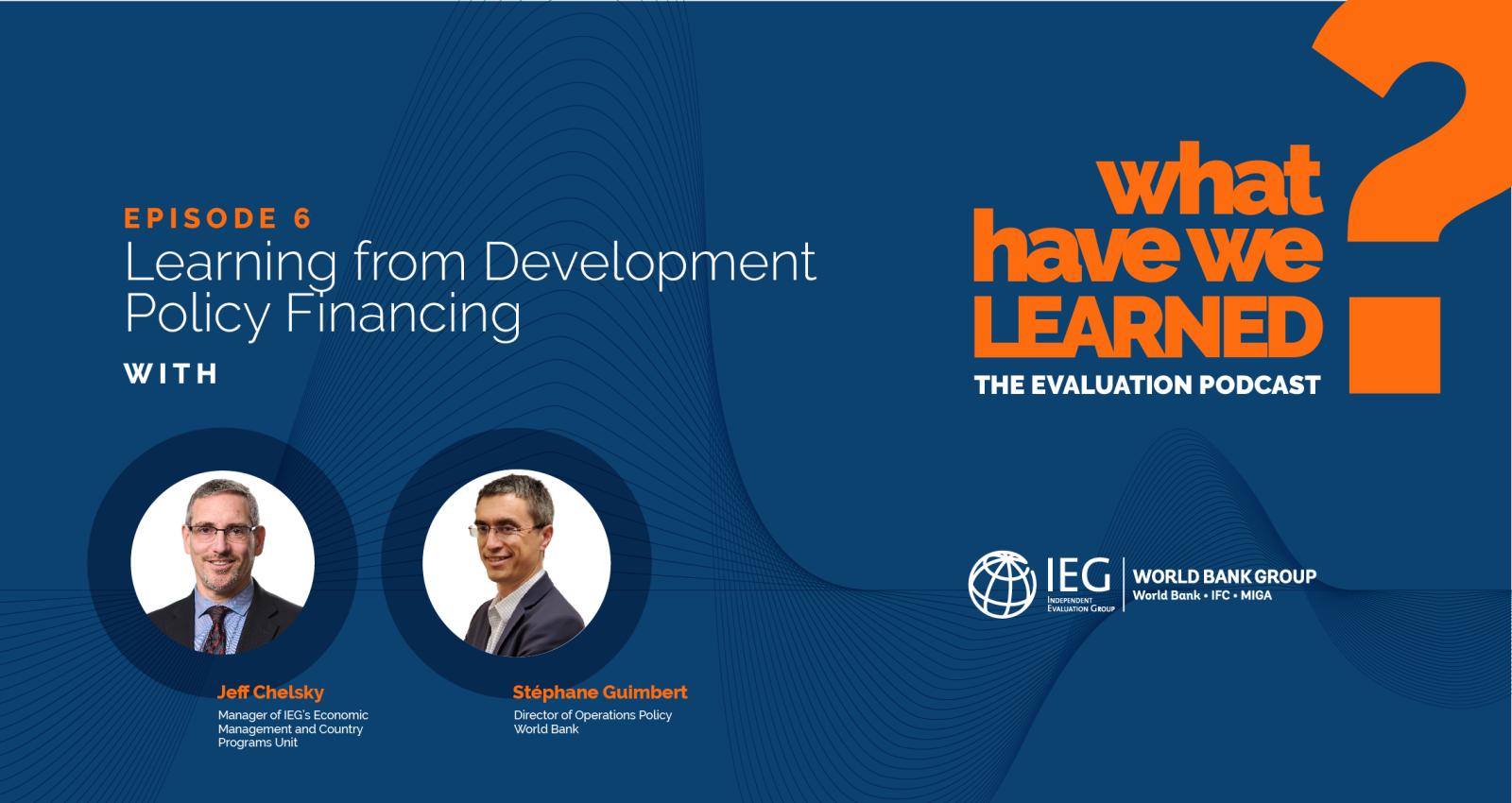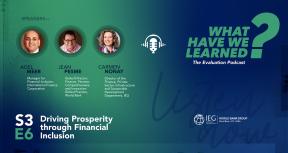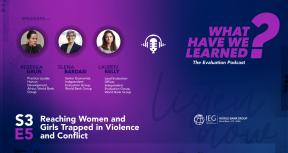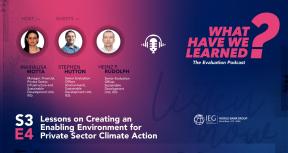Development Policy Financing (DPF) is a major instrument of multilateral development banks and has played a prominent role in the World Bank’s pandemic response. Also known as policy-based lending, DPF is a fast-dispersing instrument that provides non-earmarked funds to a country's national budget. How does DPF work and how successful has it been in achieving its various objectives? The World Bank’s Director of Policy Operations, Stéphane Guimbert, and IEG host Jeff Chelsky take stock of the trends and lessons of using policy-based lending to support developing economies.
Listen on Spotify, or Apple Podcasts.
Related resources
- World Bank Report – 2021 Development Policy Financing Retrospective: Facing Crisis, Fostering Recovery (2022)
- IEG Evaluation – Addressing Country-Level Fiscal and Financial Sector Vulnerabilities: An Evaluation of the World Bank Group’s Contributions (2021)
- IEG Evaluation – World Bank Support for Public Financial and Debt Management in IDA-Eligible Countries (2021)
- IEG Evaluation – The International Development Association's Sustainable Development Finance Police: An Early-Stage Evaluation (2021)
Conversation highlights
[00:04-07:55] How does Development Policy Financing (DPF) and its prior actions work?
[07:56-14:44] What are key lessons emanating from the Bank’s fifth DPF Retrospective?
[14:45-20:07] The role of Development Policy Operations (DPOs) in crisis response.
[20:08-22:25] Measuring success – what makes a DPO good?
[22:26-25:08] The use of DPOs in countries affected by fragility, conflict or violence (FCV).
[25:09-27:30] Determining the size of a Development Policy Operation.
TRANSCRIPT
Jeff Chelsky: Good day. Today's episode deals with one of the major financing instruments that the World Bank uses to support developing economies. Development Policy Financing, also known as policy-based lending, is a fast-dispersing instrument that provides non-earmarked funds to a country's national budget. Many of you may be familiar with the prominent role development policy operations, or DPOs, have played in the World Bank's recent response to the COVID pandemic. While often used counter-cyclically to offset the fiscal impact of economic downturns, DPOs are also used outside the context of crises to support longer-term reform.
Jeff: So how does this instrument work and how successful has it been in achieving its various objectives? Welcome to What Have We Learned from the World Bank Group's independent evaluation group, IEG. I'm your host, Jeff Chelsky, and today we'll be discussing the lessons learned from the World Bank's experience with policy-based lending. With me in the studio is Stéphane Guimbert, Director of Operations Policy at the World Bank. Stéphane, bonjour.
Stéphane Guimbert: Thanks for having me.
Jeff: So, let's start. Development policy financing differs in important ways from lending for traditional bricks and mortar investment projects. Can you explain to our listeners what a World Bank DPO is and how it's used to help developing economies achieve their development objectives?
Stéphane: Thanks Jeff, I think you almost gave the answer, which is to focus on achieving the government's development objectives. So, it's really where it starts from looking at what the government wants to achieve. And often what we've learned in development is that this is not just about building bridges or financing cash transfers, it's about making policy and institutional changes. So essentially that's what those development policy operations support, and that way they're different from the other instruments. This is an instrument that is supporting a set of policy and institutional changes that the government wants to implement.
Could be changing the tax code, could be reforming electricity tariffs so that the sector is more sustainable, and creates an incentive for the cleaner sorts of energy. Could be changing the coverage of a social protection scheme. It could really be in all sorts of sectors but focused on actions that the government takes to change its policy and strengthen its institution. That's a lesson we've learned in development. Development is not just about building, new infrastructure, as important as that is. It's also about evolving institutions and policies.
Jeff: Just to clarify for listeners, when you talk about a DPO having an action, so we're talking about prior actions. So this will be a specific reform or something that the government needs to do in order to be eligible to receive the money?
Stéphane: So those prior actions are a critical part of a broader reform agenda that the government owns and has decided. And the disbursement of this operation is based on the achievement of those actions. So in the area of climate, it could be phasing out a fossil fuel subsidy, could be introducing a tax on carbon. The range of potential actions that are in the government's program is pretty wide.
Jeff: Now, one feature of DPOs that's often not well understood is that the financing provided does not go directly to finance the reforms supported by the operation. Money goes into a central treasury or budget account and is not earmarked for any of the particular purposes or sectors, even when the prior actions that are required to obtain approval for disbursements are concentrated in a particular sector. This seems a bit counterintuitive. Can you explain the rationale for not linking financing to the reforms that the operation is intended to support? How could the Bank be sure that the reforms supported by the DPOs' prior actions will be sustained once the country has received the money?
Stéphane: Yeah, these are two very good questions. I think you call them counterintuitive because they differ from the way we traditionally think of projects. Again, we think of project as financing a bridge, a road, or a dam. And if you think it that way, you can cost the physical infrastructure that you're financing. Development policy operation is very different. It's supporting a set of policy and institutional changes within a fiscal framework, within the broader budget, and in an environment where we believe the macroeconomic framework is adequate.
So you cannot really cost the value of a particular change. In fact, often the strength of a development policy operation is not the sum of each of the prior actions. It's actually the combination and the interaction between the different actions that the government is taking. So, it'll be quasi-impossible to try and cost them. So that's why we are really not thinking of the amount in a development policy operation as the cost of the actions, but it's part of a program that the Bank is supporting and that the budget is financing. So that's for your first question on why aren't we linking directly financing reforms in the operation.
Stéphane: The second question is also a very important one. The sustainability question, essentially. Again, let's change the example, if you think about building a school, you will think about sustainability as- Will the physical building stay up? Will teachers come to teach? and Will there be material for teaching? In a government policy operation, it's all about these policy and institutional actions, and the questions are- Will these actions be sustained over time? and Will they deliver the government outcomes in a sustainable manner over time?
I think here, there are two parts to the answer. One is that we tend to prefer doing these operations in a programmatic way. By this we mean instead of doing only one operation supporting today one set of actions, we like to think of these operations as a series of operations supporting a first set of actions this year, and maybe a second set next year, and maybe a third set in two years. And if you think about this change process in a way in a more programmatic sense, this is likely to increase the sustainability of the reforms.
Stéphane: The other part of the answer, which in a way is connected, is to not think of those operations in isolation but to see them as part of a broader engagement that the Bank, but typically in partnership with the IMF or the MDBs, other partners, sustained engagement, where before we even consider the development policy operation, we worked with the government thinking through reform priorities, how to design those policy and institutional changes. And then after the development policy operation, after those actions are taken, continued engagement through, again, analytical work or technical assistance on sometimes some other form of financing. But it's part of the judgment toward thinking whether this is a good operation, do we believe the policy and institutional changes that are being supportive are sustainable.
Jeff: Now, the World Bank recently published the Development Policy Financing Retrospective, which I understand reviews trends and performance of DPOs approved over the last five years. Now, in the report, you highlighted number of strengths of the instrument in supporting countries as they implement policy and institutional reforms. Can you summarize some of the key findings of the retrospective, including lessons for future use of policy based lending?
Stéphane: Sure. Very happy to. It's a very important exercise actually, those retrospectives. It's a kind of stock-taking exercise we do every couple of years. So it's building on a lot of accumulated experience. It’s just a kind of housekeeping of reviewing the instrument. Is it working as intended? Are we using it the way that we think is most optimal? Overall, it's a report you can access. It confirms it's a very effective instrument. As I said, supporting policies and institutional reform is at the core of development, and that's our key instrument to do this, and it's in high demand from the countries we are aiming at supporting.
So overall, the basic finding is to confirm the fit for purpose of the policy and to document how we've been using the instrument over the past five years. And then at each of these retrospectives, we drill down on topics that we believe are of particular relevance at the time we do the retrospective. So obviously this time we focus on crisis response. DPOs, and I think you mentioned that in your initial introduction, we use DPOs all the time, not just in crisis. But they play a particular role during a response to a crisis because they can provide quick liquidity to governments at a time when they're badly needed. So that's extremely helpful. It's not pure liquidity support, and that's something we review in the retrospective, it's a good time to support difficult choices, and difficult policy changes that governments have to make in the middle of a crisis.
Stéphane: So during COVID, a lot of those were in the health sector, obviously, but also in expanding social safety nets, there were quite a few tax breaks and other SME-targeted policy measures. So we confirmed that DPO is a critical instrument for crisis response. Perhaps what is more new over the past couple of years, and in particular for this crisis, is that we had introduced quite a few years ago something we call, I'm going to use one acronym, I haven't used too many so far, is that we use Cat DDOs. So Cat, it's an easy acronym. Cat for catastrophe, DDO for deferred drawdown. So what it means is that it's a development policy operation, the same set of reforms that you support, but instead of dispersing the amount that is committed immediately, you set it aside and the country can call on that amount when there's a disaster striking.
And we had done a lot of those over the past couple of years, and just in the first couple of weeks when COVID hit, the countries were able to immediately draw down on those resources. And this has proven a very effective tool, in particular, because the policy actions that typically those countries will have taken in advance are all about crisis preparedness. And I think, unfortunately, we've learned with COVID that the world is not where we should be in terms of crisis preparedness. So one first set of recommendations of the retrospective is actually to further the use of these particular forms of development policy operations.
Stéphane: So that's one big set of recommendations. The other is to look at the number of aspects of what at the Bank we call the "green, resilient, inclusive development". So how after COVID in particular, after the crisis, do you make sure the recovery is green, resilient, and inclusive? In terms of resilience, we looked in particular at the use of this instrument for countries that have debt vulnerabilities, and as we know, this is unfortunately again proving a particular challenge for a number of countries, IDA countries in particular. And so development policy operations can be very helpful instruments in that area to support countries that are increasing their revenues, making their debt contracts and debt accounts more transparent, and streamlining some of the subsidies on the expenditure side. So that's one set of recommendations about the use of different policy operations for fiscal and debt-related issues.
On the growth side, we look at DPOs that are supporting reforms to enable the private sector to grow, and we believe there's a potential to do more. There's a lot of debate at the moment in the development aid community, on how to mobilize more private capital, and that's a very important discussion, but the most important part of that discussion is how to reform countries' business enabling environment so that they are more attractive to the private sector, and development policy operations have a big role to play there.
Stéphane: The third area we look at in terms of inclusion is- how we can further the use of development policy operations for gender? The tool has been used for a lot of important policy reforms in the gender area, but we've observed some very promising and interesting innovations and improvements, for instance in an operation in Albania to further the agenda on gender equality, looking at areas like gender-based violence, the leadership of women in government and corporate governance, areas that maybe were less the focused of earlier gender-focused operations.
And the last area where we are making recommendations is on climate change. A lot of the action that's necessary on climate change is on the policy and institutional side. It's not only about new solar and wind turbines, it's also making some changes on the institutional and policy side. And we've already seen a big improvement. Only five years ago at the beginning of the retrospective, only a fraction of the development policy operations had anything to do with climate change. Our last fiscal year, we had 96 or 97% of DPOs that have at least one action on climate change. So only having one action is certainly not sufficient and not where we want to end, but it shows already we are moving in the right direction and we have the potential to use the instrument some more.
Jeff: Now, I want to go back to what you were talking about when you were talking about crisis preparedness. IEG recently did an evaluation of World Bank Group's support for addressing country-level fiscal and financial sector vulnerabilities. And this report concluded that the World Bank makes more effective use of DPOs and other Bank instruments when responding to an economic crisis than in strengthening institutions that contribute to longer-term resilience and crisis preparedness outside of the context of a crisis. The old expression is "never let a crisis go to waste". I guess that's sort of what it was reflecting. How would you respond to this assessment? Are DPOs less effective at longer-term institution building than as countercyclical macro-economic support?
Stéphane: No is the short answer. I do agree though that whether it's this instrument or another instrument, as you say let a good crisis go. In terms of policymaking and focus, crises do focus the attention. So often, a lot of these actions are taken at the moment of crisis. So I do agree that DPOs have a particular role to play in crisis response, although I want to be quite clear that this is one of the many areas where we need to remember the respective roles of the different institutions. So DPOs have a clear role to play and they do play a somewhat countercyclical role, but that's also an area where we work very closely with the IMF, which in the international financial architecture has the lead role in countercyclical financing. The other point I'd make is that in particular during the COVID response, we've seen that there are many other tools and types of projects that are critical for crisis response.
Stéphane: So the obvious example that's most directly related to COVID are the health projects initially to finance protective equipment and later to finance the vaccine. Those were very fast-acting, providing very quick support, very targeted to the source of the crisis.
The other part is social protection schemes. More countries today have social protection schemes than 15 years ago, and the Bank is engaged with a lot of countries supporting social protection schemes, and we were able very quickly to scale up some of those projects and in particular target those that were most vulnerable during the COVID crisis. So the point here is that DPOs play an important role, but they're not the only crisis tool in the Bank's toolkit in the way we support countries in response to crises.
Jeff: Now, I completely understand how countries in crisis, whether or not it's COVID or collapse in commodity prices and revenue dries up or expenditure increases. So the money is very attractive. How do you decide which of the countries' many reform priorities you are going to support with that DPO?
Stéphane: There are multiple dimensions to this, but maybe the one I emphasize most is the point I made earlier on the continuity of engagement. So we are going to primarily focus on areas where we've been engaged. So we don't come cold on things we don't really understand, the governments have reform programs that are way bigger than the World Bank can engage with, so we are really focused on the areas where we believe we can bring some value addition and we are engaging on a sustained basis. And again, it's this point about ownership. We don't choose the prior actions, we engage where we believe there's a strong demand as articulated by our counterparts in the government.
Jeff: This is interesting because it relates to a recommendation that is, as I do some self-promotion, has come up in a couple of IEG evaluations, one on Public Financial and Debt Management and another on the Sustainable Development Finance Policy, which talks about the importance of having in place the analytics and the diagnostics so that when a crisis occurs you know which sort of reforms should be the priority.
Stéphane: Maybe if I can just chip in on that, you'll see in this retrospective, since you're doing self-promotion, I might as well, you'll see a short section on this, but in fact, if you look at pretty, every of our retrospective on DPOs, the quality of the analytical underpinnings is consistently a driver of the success in those operations. And in fact, we make it a point in every program document of those operations to document the analytical underpinnings. Now, I do admit that in crisis response, you might have to act on areas where you have actually slightly less analytical underpinnings, but as a general point, fully agree with this finding about the quality of analytics behind those operations.
Jeff: Now, at the IEG, we regularly assess and rate the extent to which DPOs achieve their objectives. In your opinion, how do you know when a DPO has been successful? In fact, what does good look like when it comes to DPOs?
Stéphane: Great question as well. You've picked up the theme of my answers by now. Like for other projects, which is start with the development outcomes that you are trying to achieve, and then choose which instrument fits better for that. And so a good DPO is one that achieves those development objectives. Now, of course, this is all about long-term development, so it might take some time before you know whether you're achieving your objective. So some kind of rule of thumb as we review those DPOs when we prepare them.
One is the relevance of the actions that are supported. A good DPO will focus on the issues that matter for the country and will have substantive actions and typically as we just discussed, backed up by a fair bit of analysis, so that first point on relevance.
Stéphane: The second is also echoing some of what we've discussed before on sustainability. I think that's one of the most difficult judgment calls I think in development in general, but in the DPOs in particular, the likelihood of what you are supporting today to be sustainable over the medium term. The quality of a sustained engagement is a good indicator. Quality of consultations, so typically governments would consult through their own mechanisms around those reforms and knowing that you have a diverse set of groups who support those actions, or if there are some downsides that the government is taking action to mitigate any downside. All this gives us reassurance about the sustainability.
And then last part of a good DPO, we haven't talked too much about it, but it's critical. Because of the nature of the instrument supporting an entire budget is being confident that there's an adequate macroeconomic framework.
Jeff: Now, the DPO has evolved considerably over the last 20 years. Previously, budget support operations were largely used for countries with more developed institutional structures and governance. But today, and even before the COVID pandemic, we see budget support operations being increasingly undertaken in lower-capacity countries, including many fragile states. And the commitment value of many of these operations has actually increased significantly with the average size of a DPO in fragile situations having tripled between the first and second halves of the last decade.
Jeff: And as the retrospective notes, the share of development policy finance in total IDA commitments has increased significantly over the last five years. Has this been an intentional evolution, and if so, what has changed in the Bank's assessment of the suitability of DPOs for lower-income countries and countries in fragile situations?
Stéphane: So that's a good question. We believe this is an instrument that is relevant to all types of countries. I believe a lot of them reflect a broader shift of the entire focus of the institution toward fragile and conflict states. In particular, in IDA, FCV has been a theme for several replenishments now. And not only has it been a theme and a matter of qualitative attention, but also quantitatively there's been an increase in resources allocated to those countries.
Now, you are right that in addition, we've tried to learn how to make DPOs in those countries as relevant as possible. So we're trying to be as selective as possible in terms of the actions that we support. We try perhaps even more in FCV than in other countries to ensure that when they support at one point in time for a set of actions, it's preceded and followed by support and an engagement for the implementation.
Jeff: So if I understand in a fragile low capacity country, we're more likely to see DPOs being accompanied by other Bank lending and operations than we would in higher-income countries.
Stéphane: That's correct. Very often, it is helpful to provide also the technical assistance that will help the implementation. Often, those policy institutional actions are laws, and decrees. They are critical to the change process, but they need to be followed through. And often that requires dedicated support.
Jeff: Last question, and hopefully it's not the most difficult. So when we look over at the IMF, the size of an IMF program is linked to country-specific quota, which is calculated using an agreed formula based on the country's relative economic size and some other factors. The World Bank has no such... Well, as far as I understand, the World Bank has no such benchmark for determining the size of an operation. How do you decide how much financing to lend to a country as part of a DPO? Is there any link between the size of the DPO and the ambition of any of the reforms it's required to implement a prior action?
Stéphane: Yeah. Good question, and I'll refer you again to the retrospective, there's some analysis on this. So we do not, cost reform, we don't have a formula. But we use a number of the points that you made in the judgment. So certainly we look as I mentioned at the budget framework. So we look at the financing requirements within that budget framework, by this I mean the government's budget framework. So that's one of the criteria that we look at.
We also look at the availability of other alternative sources of financing, the availability of our own resources, whether IDA or IBRD because both for the country team and for the authorities, there's usually a tradeoff, there's a set envelope, and the more is set on a DPO, the less you will have for some other projects. So that's the spirit, that's the guidelines.
Stéphane: And if you look at ex-post, the analytic work, you'll see that obviously, the size of the country plays a role. There is an empirical link with the size of the financing needs so that we can see. And indeed, the strengths of the operation will play a part, and one way to think about that is a very strong operation typically is the combination of a lot of effort from the broader Bank engagement, and therefore, quite naturally a higher proportion of the resources available for the country will then be dedicated to the DPO. So in short, all the points you raised are factored in those decisions, but there's no formula or mechanical way to derive the amount of a particular DPO.
Jeff: Now, we're just about out of time. So first of all, I want to thank you for what I consider remarkable restraint in your use of acronyms. Thank you very much, I appreciate that. The reports mentioned in this conversation can be found on the IEG website at ieg.worldbankgroup.org/podcast.
You could listen to more conversations on that same website or on any major podcast platform. Once again, I'd like to thank Stéphane Guimbert, our guest, for sharing his views and experience with DPOs.
This has been What Have We Learned? from the Independent Evaluation Group. What global development topics would you like us to explore in future episodes? Let us know at ieg@worldbank.org. Stay curious, and ciao.
This Episode’s Featured Guests:


Stephane Guimbert leads the Bank’s operations policy reform and interpretation for all financing instruments (Investment Project Financing, Development Policy Financing and Program for Results) and Analytical and Advisory Services (ASA). As well, he provides guidance to staff on Country Partnership Frameworks (CPF), and oversee the Secretariats for the Operations Committee (OC) and for the Vice Presidents on Operational Matters (OVP) meetings. He also works to establish partnerships with other MDBs and development partners.






